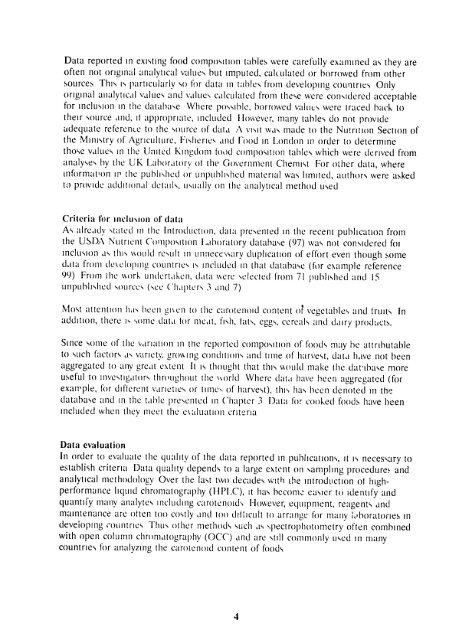the carotenoid content of foods with special reference
the carotenoid content of foods with special reference
the carotenoid content of foods with special reference
Create successful ePaper yourself
Turn your PDF publications into a flip-book with our unique Google optimized e-Paper software.
Data reported in existing food composition tables were carefully examined as <strong>the</strong>y are<br />
<strong>of</strong>ten not original analytical values but imputed, calculated or borrowed from o<strong>the</strong>r<br />
sources This is particularly so for data in tables from developing Countries Only<br />
original analytical values and values calculated from <strong>the</strong>se were considered acceptable<br />
for inclusion in <strong>the</strong> database Where possible, borrowed valIis were traced hack to<br />
<strong>the</strong>ir source and, it appropriate, included lowever, many tables do not provide<br />
adequate <strong>reference</strong> to <strong>the</strong> source <strong>of</strong> data A visit was made to <strong>the</strong> Nutrition Section <strong>of</strong><br />
<strong>the</strong> Ministry <strong>of</strong> Agriculture, Fisherie,. and Food in London in order to determine<br />
those values in <strong>the</strong> United Kingdom food composition tables which were derived from<br />
analyses by <strong>the</strong> UK Laboratory <strong>of</strong> <strong>the</strong> Government Chemist For o<strong>the</strong>r data, where<br />
informaton iP <strong>the</strong> publishCd or unpublished material was limited, authors were asked<br />
t, provide additional Ietails, uIsual ly on <strong>the</strong> analytical method used<br />
Criteria for inclusion <strong>of</strong> data<br />
As already stated in <strong>the</strong> Introduction, data presented in <strong>the</strong> recent publication from<br />
<strong>the</strong> USDA Nutrient Composition laboratory database (97) was not considered foi<br />
inclsion ais this \kould result In unnecessary duplication <strong>of</strong> effort even though some<br />
data from de\ eloplng con ntries is InclIded in that database (for example <strong>reference</strong><br />
99) From dhe work undertaken, data wkere ,elected from 71 published and 15<br />
uilpublished sources (see Chapters 3 and 7)<br />
Most attention has been given to <strong>the</strong> <strong>carotenoid</strong> <strong>content</strong> ot vegetables and fruits In<br />
addition, <strong>the</strong>re is some data hor meat, fish, fats, eggs, cereals and dairy products.<br />
Since some <strong>of</strong> <strong>the</strong> variation in tile reported composition <strong>of</strong> <strong>foods</strong> may be attributable<br />
to such factors as varietv, groing conditions and time <strong>of</strong> harvest, data have not been<br />
aggregated to any great extent It is thought that thils l id make <strong>the</strong> dat'base more<br />
useful to investigators throughout <strong>the</strong> ,\)rld Where data have been aggregated (for<br />
example, for different varieties or time, <strong>of</strong> harvest), this has been denoted in <strong>the</strong><br />
database and in <strong>the</strong> table presented in Chapter 3 )ata for cooked <strong>foods</strong> have been<br />
included when <strong>the</strong>y meet <strong>the</strong> e alKnation criteria<br />
Data evaluation<br />
In order to evaluate <strong>the</strong> quality <strong>of</strong> <strong>the</strong> data reported in publications, it is necessary to<br />
establish criteria Data quality depends to a large extent on sampling procedure and<br />
analytical methodology Over <strong>the</strong> last two decades wth <strong>the</strong> introduction <strong>of</strong> highperformance<br />
liqu1id chromatography (IPLC), it has become easier to identify and<br />
quantify many analytes including <strong>carotenoid</strong>,, However, equipment, reagents and<br />
maintenance are otten too costly and too di fticult to arrange for many laboratories in<br />
deveioping C¢ountries Thus o<strong>the</strong>r methods such as ,pectrophotornetry <strong>of</strong>ten combined<br />
<strong>with</strong> open colun chromatography (OCC) and are still commonly used in many<br />
countries for analyzing <strong>the</strong> <strong>carotenoid</strong> <strong>content</strong> <strong>of</strong> <strong>foods</strong><br />
4

















